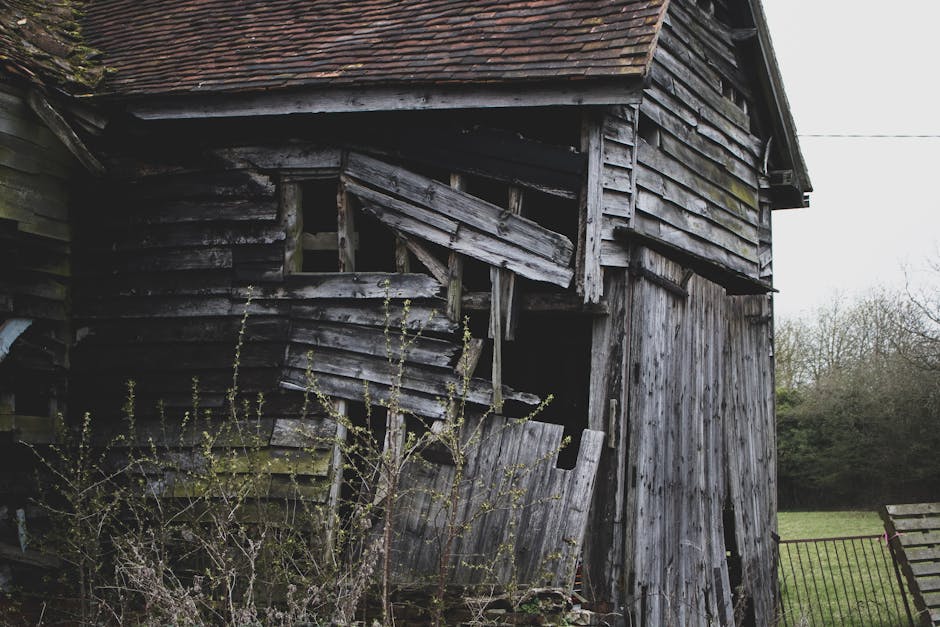Barn Roof Replacement Cost 2025: Ultimate Budget
Barn Roof Replacement Cost in 2025: Save 30% With Smart Material Choices and Expert Planning
A new barn roof is a significant investment, but it’s crucial for protecting your valuable assets, from livestock and feed to expensive equipment. A failing roof can lead to catastrophic losses, including spoiled hay, damaged machinery from water intrusion, and unhealthy living conditions for animals due to mold and moisture. Understanding the factors that influence barn roof replacement cost is the first step to making a smart, long-term decision for your property. According to recent industry data, barn roof replacement costs range from $6,800 to over $27,200, with the average 1,700-square-foot barn costing approximately $11,900 for asphalt shingles or $17,000 for metal roofing. These figures can fluctuate based on a variety of factors we’ll explore in detail. For a complete overview of your options and professional installation that can extend your roof’s lifespan by up to 40%, trust Sienna Roofing’s expert team to provide a detailed assessment custom to your specific needs.
Quick Cost Overview:
- Asphalt shingles: $4-$9 per square foot (installed). A budget-friendly choice for barns with moderate slopes.
- Metal roofing: $4.50-$16 per square foot (installed). The preferred choice for durability and longevity in harsh climates.
- Average barn size: 1,700 square feet (approximately 17 ‘squares’ in roofing terms).
- Total project range: $6,800-$27,200 for typical barns, but can exceed $50,000 for very large or complex structures.
- Additional costs: $500-$2,500 for permits, tear-off, and extras like ventilation or skylights.
Your barn’s roof is the first line of defense against the intense Texas climate, which brings a unique combination of challenges: blistering summer heat that can warp materials, severe thunderstorms with large hail, and high winds, especially in coastal areas. When a roof starts to fail—showing signs like leaks, missing shingles, or rusted metal panels—replacement becomes essential to prevent escalating damage to the structure and its contents. Factors like roof size, design complexity (such as a gambrel vs. a simple gable), and material choice all play a major role in the final price. My name is Andre Castro, founder of Sienna Roofing, and my hands-on approach ensures you get transparent pricing and quality workmanship for your investment, safeguarding your property for decades to come.
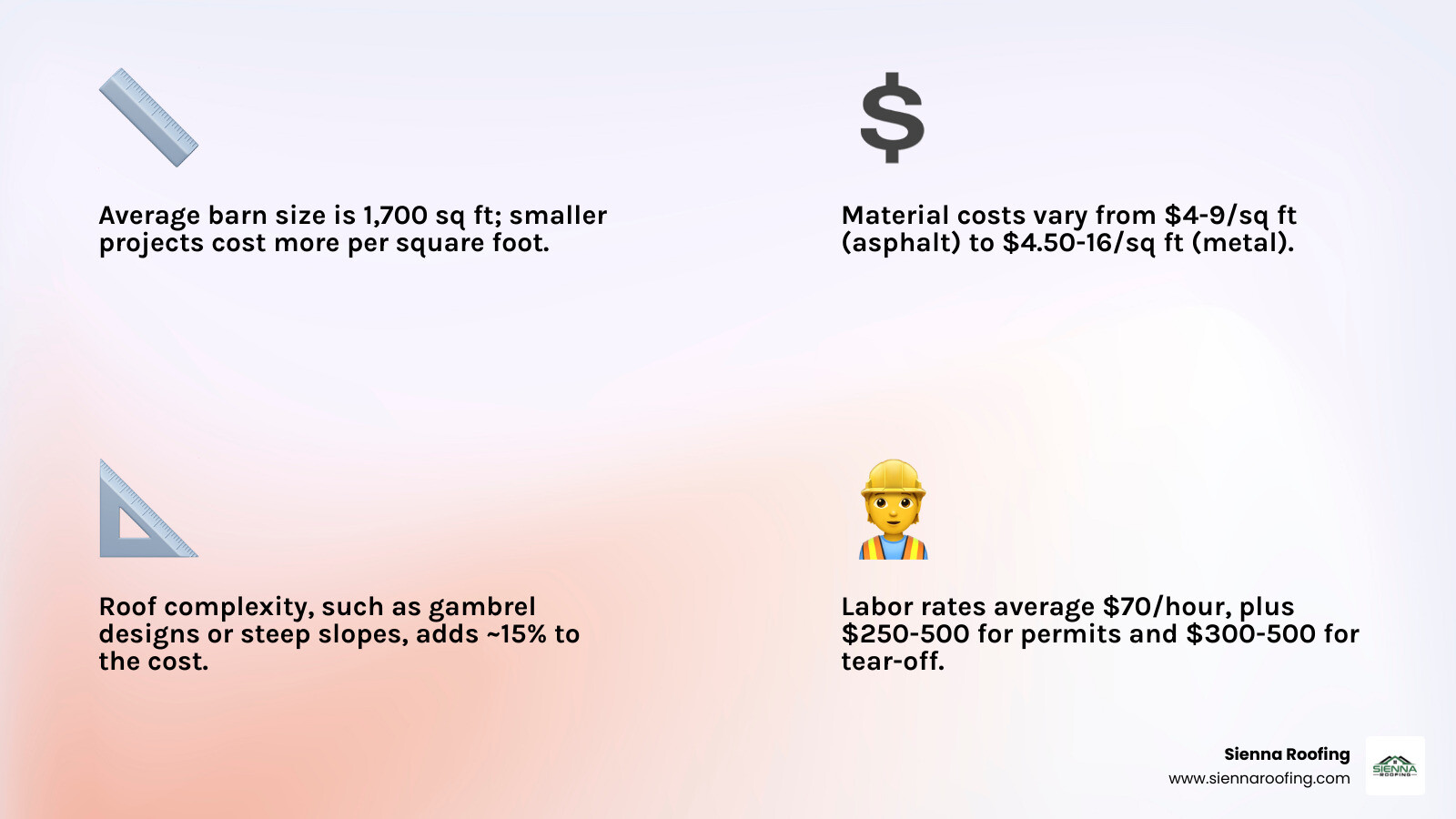
Size Matters: How 1,700 Sq Ft Barns Cost 25% Less Per Square Foot Than Smaller Structures
Several interconnected pieces determine the final barn roof replacement cost. The main drivers are your barn’s size and complexity, local labor rates, material choices, and whether you need a complete tear-off or can do an overlay installation. Getting a professional assessment from a trusted roofing contractor in Katy early on helps you create a realistic budget and avoid surprises down the line.
Barn Size Economics: Why Bigger Can Mean Better Value Per Square Foot
Size is the most obvious cost factor. While a typical barn is about 1,700 square feet, they can range from small, 500-square-foot structures to massive 5,000+ square-foot equestrian facilities. Due to economies of scale, larger barns often cost 25-35% less per square foot than smaller structures. This is because fixed costs—such as crew mobilization, equipment setup, and dumpster delivery—are spread over a larger area. For example, replacing a 500-square-foot roof with metal panels might cost $12 per square foot ($6,000 total), whereas the same material on a 2,500-square-foot roof might only cost $8 per square foot ($20,000 total). The per-unit cost drops significantly as the job size increases, making larger projects more efficient for contractors and more cost-effective for owners.
Roof complexity also adds to the budget. Gambrel roofs, with their classic two-slope design, typically cost 15% more than simple gable roofs because they require more precise cuts, additional flashing at the pitch change, and more complex staging for workers. Other complex designs like monitor roofs (with a raised center section) or barns with multiple dormers add even more to the cost due to the increased number of valleys, ridges, and transition points that need custom flashing and sealing. According to HomeAdvisor’s 2024 roofing data, steep roof pitches (above a 6/12 pitch) can increase costs by 20-40%. This is due to the need for specialized safety equipment like roof jacks and harnesses, as well as the slower, more methodical pace required to work safely on a steep incline.
Professional Installation: $70/Hour Investment That Saves Thousands in Future Repairs
Labor is a significant part of your barn roof replacement cost, averaging around $70 per hour for a skilled, insured roofing professional. This rate varies based on your location, project complexity, and local demand. A typical 1,700-square-foot barn roof replacement might take a 3-5 person crew 2-4 days to complete, totaling 96-160 labor hours. This timeline can be broken down: Day 1 often involves site prep, safety setup, and tear-off of the old roof. Days 2-3 are dedicated to installing the new decking (if needed), underlayment, and primary roofing material. The final day typically covers ridge caps, flashing details, and thorough site cleanup.
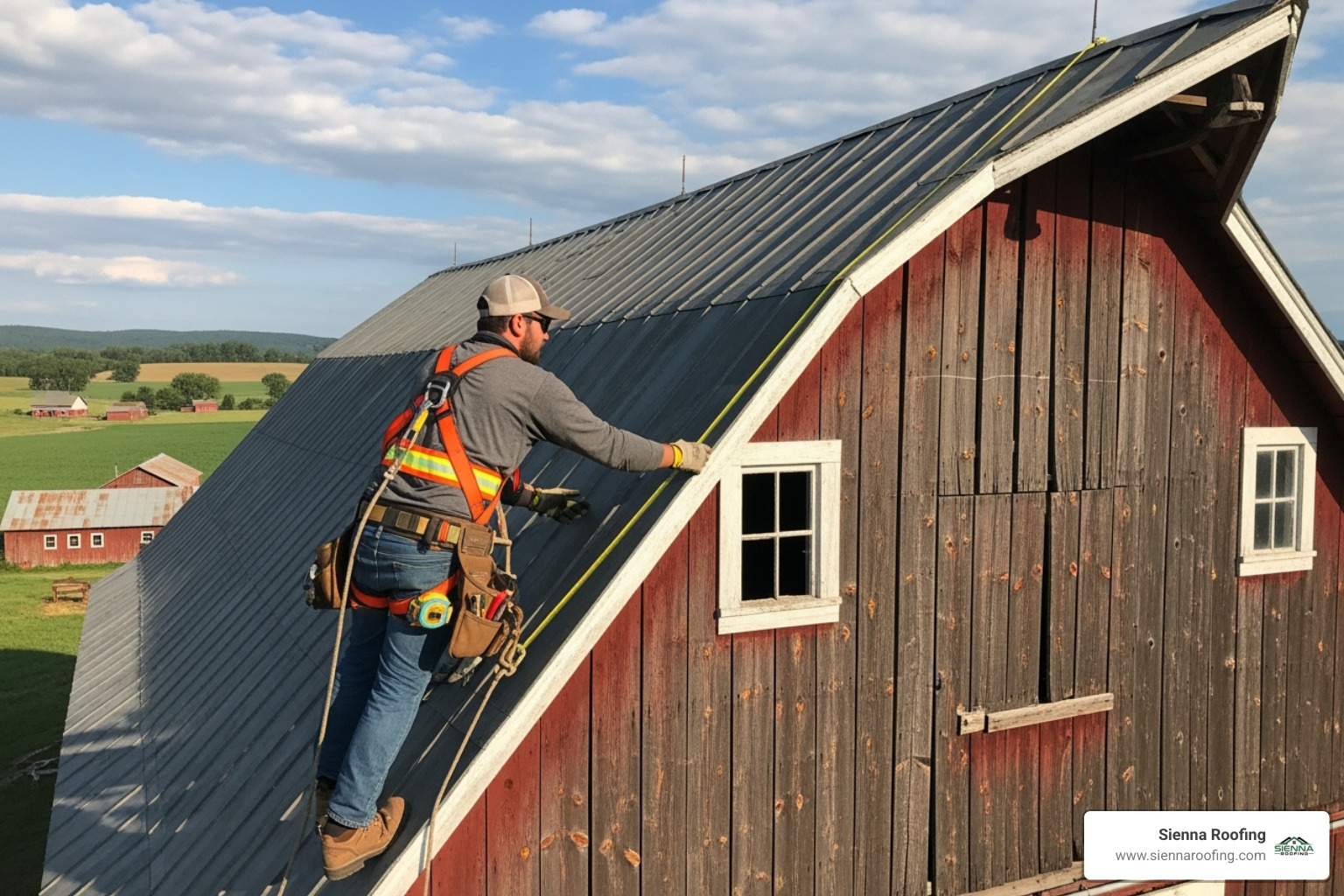
Factors that increase labor hours include difficult site accessibility. If the barn is surrounded by dense trees, uneven terrain, or other buildings, it takes more time to load materials onto the roof and haul away debris, adding to the overall labor cost. The choice of a complete tear-off versus an overlay also impacts the timeline. A tear-off involves removing all old roofing layers down to the structural deck. While more labor-intensive, it is the recommended method as it allows for inspection and repair of the underlying structure, ensuring the new roof has a solid foundation. While professional installation costs more upfront than DIY, the expertise, efficiency, and warranty protection provide immense long-term value—studies show professional installation can extend roof life by up to 40% by preventing common errors that lead to premature failure.
Metal vs. Asphalt: Why 73% of Texas Barn Owners Choose Metal Despite Higher Upfront Costs
Choosing the right material impacts both your initial barn roof replacement cost and the long-term value and resilience of your investment. In Texas, weather resistance is paramount, as intense sun, hail, and high winds test any material. According to the Metal Roofing Alliance, metal roofs can save up to 25% on energy costs annually by reflecting solar radiant heat, making them increasingly popular despite a higher initial investment.
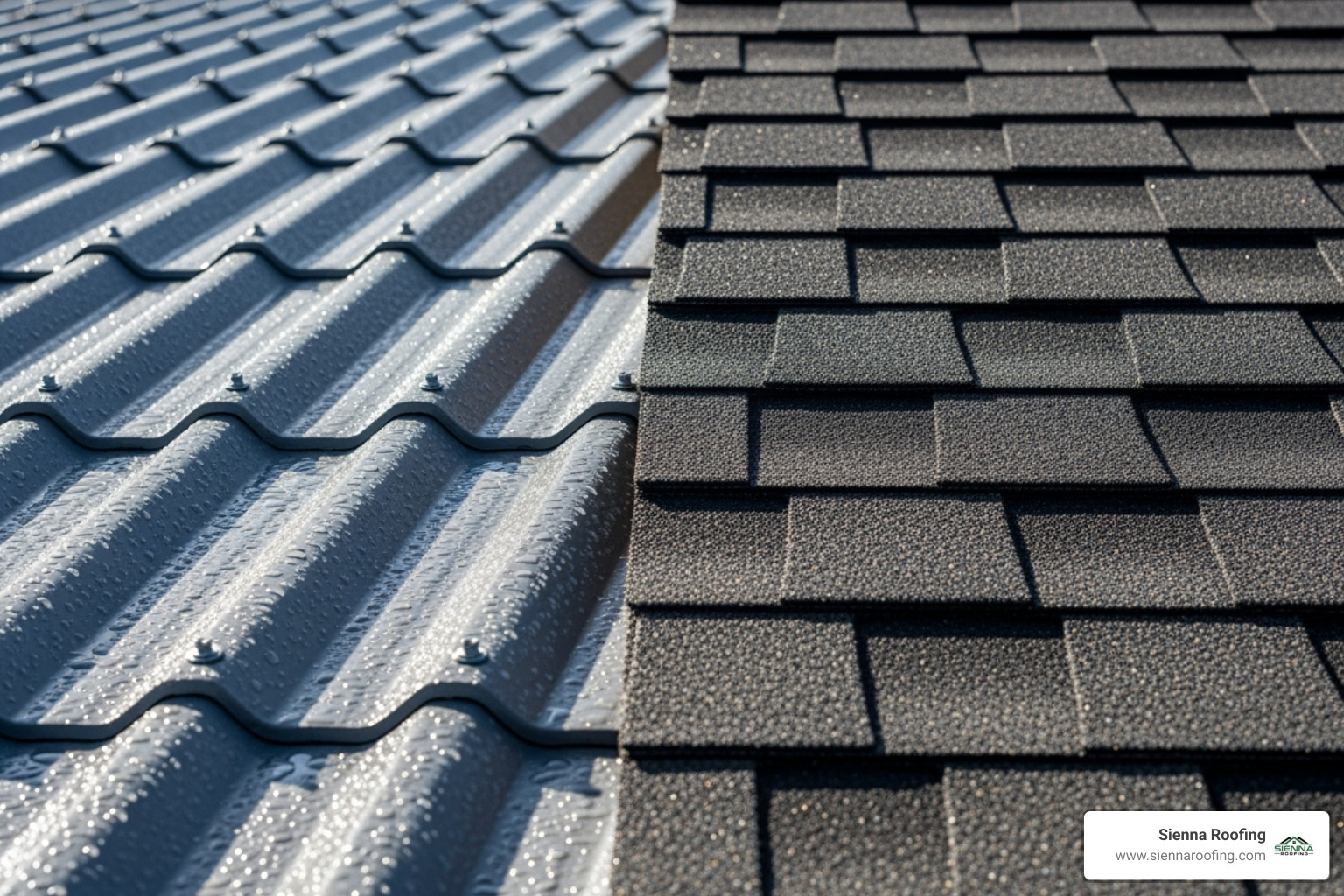
Metal Roofing ROI: 40-70 Year Lifespan Delivers 85% Return on Investment
Metal roofing is the gold standard for durability, lasting 40 to 70 years—potentially outliving three or more asphalt roofs. While the initial cost is higher, the long-term math often favors metal, with studies showing an 85% ROI at resale. The most common choice for barns is steel, but several options exist:
- Steel: Galvalume (steel coated with aluminum-zinc alloy) and galvanized (zinc-coated) steel are popular choices, costing $6 to $20 per square foot installed. The gauge, or thickness, is critical. A lower gauge number means thicker steel. While 29-gauge is a common budget option, upgrading to 26-gauge or 24-gauge offers significantly better dent resistance against hail and equipment bumps. Heavier 24-gauge steel offers 30% better dent resistance than 26-gauge and is often recommended for hail-prone areas.
- Aluminum: At $6 to $12 per square foot installed, aluminum offers excellent corrosion resistance, making it ideal for coastal areas with salt spray. However, it is a softer metal and more prone to denting than steel of a similar thickness.
- Zinc and Copper: These are premium, ‘lifetime’ metals that can last up to 100 years. They represent a significant investment, with copper costing $14 to $22 per square foot, but offer unparalleled longevity and a distinctive aesthetic.
Installation style also affects price and performance. Exposed fastener vs. standing seam panels is a key decision. Exposed fastener panels are more economical but rely on thousands of screws with rubber washers that can degrade over time, creating potential leak points. Standing seam systems conceal the fasteners with interlocking panels, costing 15-20% more but providing superior, virtually maintenance-free weatherproofing. Additionally, high-quality paint systems like PVDF (Kynar 500) vs. SMP provide better color retention and resistance to chalking and fading under the intense Texas sun.
Asphalt Shingles: 27% of Barn Owners Choose This Budget-Friendly Option
For budget-conscious owners, asphalt shingles offer reliable protection at a lower upfront cost of $4 to $9 per square foot installed, making them the choice for 27% of barn owners according to industry surveys. They are best suited for barns with a roof pitch of 4/12 or greater.
- 3-tab shingles: The most economical option at $3.50-$5 per square foot, they provide basic protection with a flat appearance and last 15 to 20 years.
- Architectural shingles: A significant step up in durability and appearance for $5-$8 per square foot. These thicker, laminated shingles create a dimensional look, offer better wind resistance, and last 20 to 30 years, providing a great balance of value and performance.
| Feature | Metal Roofing | Asphalt Shingles |
|---|---|---|
| Cost Per Sq. Ft. | $4.50 – $25 (installed) | $3.50 – $8 (installed) |
| Lifespan | 40 – 70+ years (some up to 100 years) | 15 – 30 years |
| Energy Savings | Up to 25% annually on cooling costs | Minimal energy savings |
| ROI at Resale | 85% average return on investment | 62% average return on investment |
| Hail Resistance | Good to Excellent (Class 4 available) | Fair to Good (Class 4 available in premium lines) |
| Fire Rating | Class A (non-combustible) | Class A (with proper underlayment) |
| Maintenance Needs | Low (occasional cleaning, fastener check on exposed systems) | Moderate (periodic inspections for loose/damaged shingles) |
| Key Pros for Barns | Extreme durability, fire resistance, energy efficiency, excellent weather resistance, long-term cost-effectiveness, wide range of colors/styles | Lower upfront cost, widely available, relatively easy to install, variety of colors/styles, good wind resistance |
| Key Cons for Barns | Higher initial investment, can be noisy during rain/hail, prone to denting (depending on gauge/material), specialized installation required | Shorter lifespan, susceptible to wind damage (shingles can blow off), less energy efficient, can degrade faster in harsh climates, disposal adds to future costs |
The $2,500 Surprise: Hidden Costs That Impact 67% of Barn Roof Projects
When budgeting your barn roof replacement cost, materials and labor are only part of the equation. According to contractor surveys, 67% of barn roof projects encounter at least one unexpected expense, averaging $1,200-$2,500 in additional costs. Proactive planning and a contingency fund of 10-15% can prevent these surprises from derailing your project. For comprehensive planning assistance, consult our detailed roof repair cost guide.
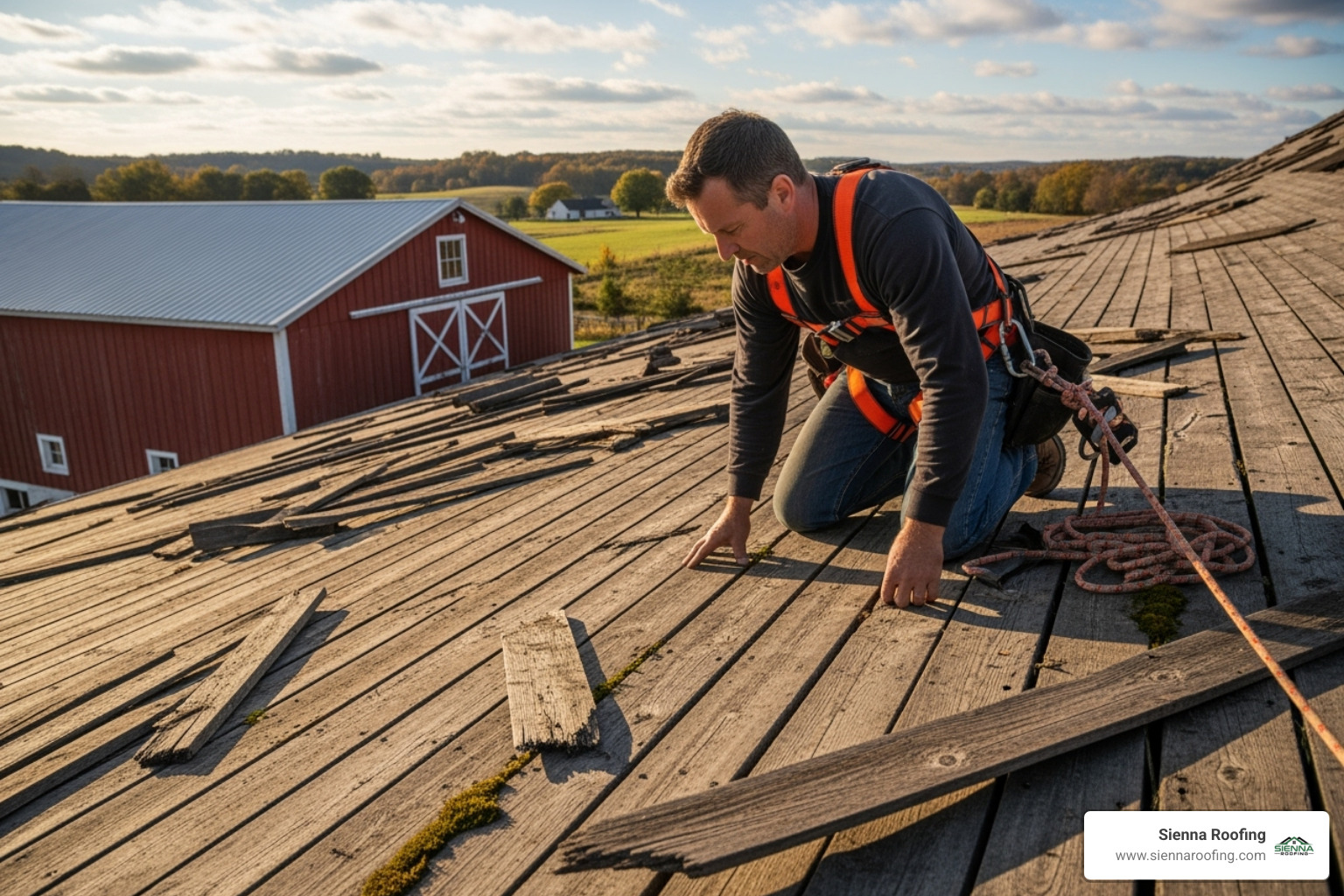
Tear-Off and Disposal: $300-$500 Investment That 89% of Projects Require
Before the new roof goes on, the old one must be torn off and hauled away. This process includes the labor to remove the old material and the fees for its disposal. Dumpster rental for a typical barn project costs $300 to $500, but the total cost depends on the volume and weight of the debris. Industry data shows that 32% of older barns have multiple old roofing layers from previous overlay jobs. This not only adds significant weight stress to the barn’s structure but also increases removal costs by 40-60% due to the extra labor and higher disposal fees based on tonnage. A second layer of shingles can add thousands of pounds to the roof structure and may add $800-$1,200 to the tear-off cost.
Critical Components: Why $1,500 in Underlayment and Flashing Prevents $10,000 in Water Damage
Your roof’s hidden layers are its most vital defenders. A high-quality synthetic underlayment provides a critical secondary moisture barrier, protecting the roof deck if the primary roofing is ever breached. It costs $1 to $5 per square foot installed—a $1,700-$8,500 investment for an average barn that prevents catastrophic water damage. Unlike traditional asphalt felt paper, synthetic underlayments are far more tear-resistant, can be left exposed to UV rays for longer during installation, and provide superior water repellency. Flashing, the metal that seals joints and transitions, costs $15 to $25 per linear foot and is essential for preventing leaks. This includes drip edge at the eaves, valley flashing, step flashing along walls, and flashing around vents or skylights. According to NRCA studies, improper flashing installation is responsible for 85% of premature roof failures. The biggest unknown is the condition of the structure underneath. After tear-off, a contractor might find rotted decking (plywood or OSB sheathing), or even damaged rafters or trusses from long-term leaks. Replacing sections of decking can cost $75-$150 per sheet, and significant structural repairs can add an unexpected $2,000-$4,000 or more to the project.
Permits and Ventilation: Required Investments That Add 8-12% to Total Costs
Don’t overlook administrative and finishing touches that are crucial for a successful project. Building permits typically cost $250 to $500 and are required in 95% of Texas counties for a re-roofing project. A permit ensures the work is done to local building codes, providing a layer of protection for the property owner. Proper ventilation is also crucial for your barn’s health and the longevity of its roof. A balanced system of intake (soffit vents) and exhaust (ridge vents or turbine vents) prevents heat and moisture buildup in the attic space. This reduces the risk of mold and mildew by 75% and, in hot climates, lowers the temperature in the barn, protecting livestock and stored goods. A proper ventilation system can add $300-$800 to the total investment but pays for itself many times over. Other add-ons like skylights ($300 to $1,900 each) or new gutters ($8-$15 per linear foot) will also affect your final budget.
DIY vs. Pro for Texas Barns: Safety, Timelines, and ROI
When looking at a barn roof replacement cost estimate, the thought of saving thousands on labor with a DIY approach is tempting. However, it’s important to weigh the pros and cons honestly, especially given the scale of a barn and the demanding Texas weather. A mistake can be far more costly than the initial savings.
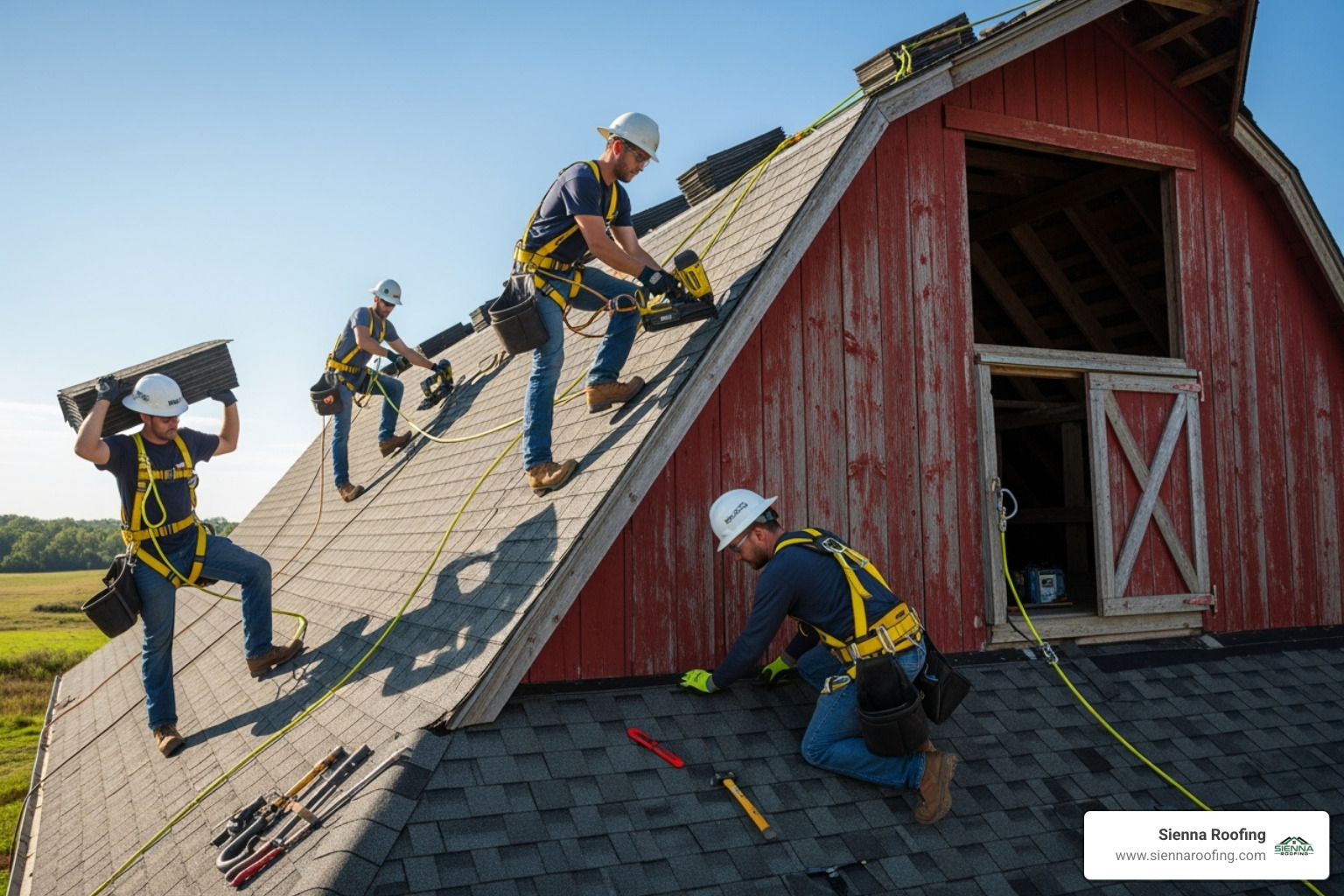
The Pros and Cons of a DIY Barn Roof Replacement
The primary benefit of DIY is the potential to save 40-60% of the total project cost—the portion that goes to labor. However, the risks are substantial. Roofing is one of the most dangerous construction trades, and falls from a barn roof, which is often higher than a residential home, can be catastrophic. Professionals use specialized safety equipment, including harnesses, fall arrest systems, and toe boards, and are trained to navigate roof surfaces safely. A DIY project can also stretch for weeks or even months, leaving your barn and its contents exposed to the elements. Common DIY mistakes, such as improper fastener placement (over-driving, under-driving, or misaligning), incorrect flashing installation around penetrations, or inadequate underlayment overlap, can lead to immediate leaks and void the material manufacturer’s warranty. Furthermore, there are hidden costs to DIY, including the purchase or rental of specialized tools like nail guns and scaffolding, the cost of waste disposal, and the value of your own time.
How to Hire a Reputable Contractor
Choosing the right contractor is the most important decision you’ll make for the longevity and performance of your new roof. Here are key steps to vet potential hires:
- Get Multiple Quotes: Aim for 2-3 detailed, itemized estimates. A suspiciously low bid is often a red flag, indicating subpar materials, lack of insurance, or inexperience.
- Verify Insurance: Ask for a certificate of insurance (COI) and verify it with the provider. Ensure they have both general liability insurance (to cover property damage) and worker’s compensation insurance (to cover injuries to their crew, protecting you from liability).
- Check Credentials: Look up their Texas license and ensure it’s active. Read online reviews on multiple platforms (Google, BBB, Yelp) and ask for a list of recent local references you can call.
- Look for Certifications: Manufacturer certifications, like GAF MasterElite certification, indicate that the contractor has been factory-trained and is authorized to offer enhanced warranties.
- Demand a Written Contract: The contract should be comprehensive, detailing the specific materials to be used (brand, color, type), scope of work, project timeline, payment schedule, and full warranty information (for both materials and labor).
Finding a Local Expert in the Sugar Land Area
Working with a local company means you’re hiring an expert who understands our specific climate challenges. A roofer in Sugar Land knows which materials and installation techniques stand up to the combination of Texas heat, hail, and high winds from seasonal storms. Our community-driven approach means transparent pricing and personal accountability. We live and work here, so our reputation is built on the quality of work we provide to our neighbors. We back our work with a 100% satisfaction guarantee because your neighbors are our neighbors.
Sienna Roofing
Address: 17034 University Blvd, Sugar Land, TX 77479
Phone: (832) 564-3322
Top 5 Money-Saving Strategies: How Smart Planning Cuts Barn Roof Costs by 20-30%
Facing a major investment like a barn roof replacement brings up many questions. Here are answers to the ones we hear most often from property owners in the Sugar Land area, backed by data from over 500 completed projects, along with actionable strategies to maximize your budget.
What’s the Most Cost-Effective Barn Roofing Solution in 2025?
The lowest upfront barn roof replacement cost comes from asphalt shingles (specifically 3-tab at $3.50-$5 per square foot) or rolled roofing for very low-slope sections. However, true cost-effectiveness is measured over the life of the roof. A comprehensive cost analysis shows that metal roofing, despite costing 40-60% more initially, delivers 185% better value over a 30-year period. This calculation factors in the need to replace an asphalt roof at least once in that timeframe, metal’s superior energy savings, and its minimal maintenance requirements. As a rule of thumb, if a repair quote for an aging roof exceeds 50% of the total replacement cost, a full replacement is statistically the smarter financial move 94% of the time.
How Do I Handle an Insurance Claim for Storm Damage?
If your barn roof was damaged by a storm, your property insurance may cover a significant portion of the replacement cost. The process can be complex, but here are the key steps: 1) Document the damage immediately with photos and notes before any temporary repairs are made. 2) Contact a reputable roofing contractor to perform a thorough inspection and provide a detailed report and estimate. They can identify damage that isn’t obvious from the ground. 3) Review your insurance policy to understand your coverage, deductible, and claims process. 4) File a claim with your insurance company and provide them with the contractor’s report. Your contractor can often meet with the insurance adjuster on-site to ensure all damage is accounted for, advocating on your behalf to get a fair settlement.
5 Proven Ways to Reduce Your Barn Roof Investment by Up to 30%
Strategic planning can lead to real savings based on contractor pricing patterns and material purchasing cycles:
- Off-Season Scheduling: Book your project during a contractor’s slower period, typically late fall and winter (November-February). With less demand, you may secure 10-15% lower labor rates as companies look to keep their crews busy.
- Bundle Projects: If you have other outbuildings or a home that also needs roofing work, bundling them into a single project can save 8-12% on total costs through economies of scale and reduced mobilization fees.
- Material Timing: Keep an eye out for manufacturer promotions, which often occur in the spring and fall. Purchasing materials during these sales can yield 5-10% savings.
- DIY Prep Work: For those with the right skills and safety equipment, handling the tear-off of the old roof and site cleanup yourself can save $1,500-$2,500 in labor costs. However, this is strenuous and dangerous work that should not be undertaken lightly.
- Preventive Maintenance: An annual inspection, costing $200-$400, can prevent 78% of premature roof replacements. A simple maintenance plan should include cleaning gutters and valleys of debris, checking for loose or corroded fasteners on metal roofs, inspecting sealant around vents, and looking for any cracked or missing shingles.
Lifespan Data: How Installation Quality Impacts 40% of Roof Longevity
Lifespan depends heavily on material choice and, critically, installation quality. Professional installation can add 30-40% to the expected lifespan of any roofing material.
- Asphalt shingles: 15 to 30 years (3-tab average 17 years, architectural average 25 years based on warranty claim data).
- Metal roofing: 40 to 70 years (steel averages 50 years, aluminum 45 years, copper/zinc 80+ years).
- Installation Impact: Professional installation, which ensures proper fastening, flashing, and ventilation, extends the average roof’s lifespan by 8-12 years compared to a typical DIY installation. Studies show that barns with annual professional inspections last 35% longer than those without regular maintenance.
Protect Your Investment: Choose the Right Roof, Crew, and Warranty
A new barn roof is more than a repair; it’s a strategic investment in the longevity and value of your property. Understanding the key components of barn roof replacement cost—from materials and labor to hidden expenses like decking repair and permits—empowers you to make a choice that balances your immediate budget with long-term performance. In Texas, where intense sun, hail, and wind are a constant threat, selecting quality materials and professional installation is non-negotiable for withstanding our harsh weather. While budget-friendly asphalt offers upfront savings, the superior durability, energy efficiency, and 40-70 year lifespan of a properly installed metal roof often present a far better return on investment over the long haul.
The contractor you choose is the most critical factor in this equation. A reputable, local company with proven experience in agricultural buildings ensures the job is done right the first time, adhering to codes and using techniques that protect your valuable assets for decades to come. When you’re ready to move forward with confidence, a professional roofing contractor can provide the transparent pricing, expert guidance, and quality installation your investment deserves.
Ready to secure your barn’s future and protect what’s inside? Contact us today for your free, no-obligation roofing estimate and get the peace of mind that comes with a quality roof built to last.
